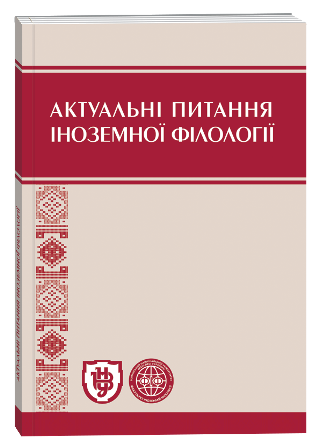EMOTIVE PHRASEOLOGICAL UNITS TO INDICATE THE EMOTION OF ANGER IN SPANISH
DOI:
https://doi.org/10.32782/2410-0927-2023-19-4Keywords:
Spanish phraseology, phraseological unit, emotivity, emotion, anger.Abstract
The article provides a brief description of Spanish phraseology and phraseological units in particular. The main approaches to the study and categorization of phraseological units have been studied. The concepts of emotions and emotivity, their expression in the cultural and social life of Spain and Spanish-speaking countries, as well as the importance of emotions in the language picture of the world of an individual in particular, are considered. The division of emotions according to the version of various scientists is considered and the classification according to the version of Izard is presented. The division of emotions into positive and negative is explained and the expediency of researching negative emotions is substantiated. Since, according to Izard's version, there are seven emotions with a negative connotation and three with a positive one, for this article it was appropriate to take the emotion with a negative connotation. The most concentrated emotions are manifested in phraseological units, which is why the analysis is given based on their examples. Phraseological units denoting the emotion of anger are considered in detail. A verb component was found in all phraseological units. Among the verbs there are those that will indicate upward movement, downward movement, transformation into another state, as well as the movement of fluid (in the study, it is blood) in the body. The verbs that are presented in the article as part of a phraseological unit to indicate the emotion of anger are the following: sacarle a uno, mandar, freír, buscar, encontrar, hervir, bajar, estar, ponerse, caerse, mojarse, llevarle a uno. Regarding the grammatical forms that are mainly used, it is the present tense, because it is important for the speaker to express feelings at the moment, other grammatical forms are the past tense and the imperative verb. The past tense is used to indicate the effect of a certain event or situation on an individual, while the imperative is used by the addressee to avoid the addressee. Since all the examples are taken from mass media sources, the phraseological units are very relevant in modern Spanish. In summary, this article shows the importance of studying phraseology and emotional phraseological units, in particular, a semantic analysis of phraseological units expressing anger in Spanish is carried out.
References
Жох І. П. Емотивні фразеологічні одиниці з компонентом corazón в іспанській мові. Одеський лінгвістичний вісник. Одеса, 2014. С. 81–84.
Жох І. П. Світлі і темні кольори в емотивній фразеології в іспанській мові. Чинники розвитку філологічних наук у ХХІ столітті : матеріали міжнародної науково-практичної конференції, 25–26 жовтня 2013 р. Львів, 2013. С. 88–90.
Жох І. П. Соматичний компонент cabeza у емотивних фразеологічних одиницях в іспанській мові. Сучасна філологія : теорія і практика : матеріали міжнародної науково-практичної конференції. Одеса, 2014. С. 83–85.
Жох І. П. Формування професійної компетентності перекладача та особливості перекладу емотивних фразеологічних одиниць (на матеріалах іспанської мови). Modern problems of management: economics, education, health care and pharmacy : тези. Ополе, 2014. С. 97–99.
Селіванова О. Сучасна лінгвістик: термінологічна енциклопедія. / О. Селіванова.– Полтава : Довкілля – К., 2006. –716.
Corpas Pastor G. Las lenguas de Europa: Estudios de fraseología, fraseografía y traducción. Granada : Comares, 2000.
García-Page Sánchez M. Introducción a la fraseología española : estudio de las locuciones. Barcelona : Anthropos, 2008.
Izard C. E. Basic emotions, relations among emotions, and emotion-cognition relations. Psychological Review, 1992. № 99. P. 561–565.
Montoro del Arco, Esteban T. Teoría fraseológica de las locuciones particulares. Las locuciones prepositivas, conjuntivas y marcadoras en español. Frankfurt am Main : Peter Lang, 2006.
Penadés Martínez I. La hiponimia en las unidades fraseológicas. Cádiz : Servicio de Publicaciones de la Universidad de Cádiz, 2000.
Seco M., Andrés O., Ramos G. Diccionario fraseológico documentado del español actual. Locuciones y modismos españoles. Madrid, 2005.
Wotjak G. Las lenguas, ventanas que dan al mundo : el léxico como encrucijada entre morfosintaxis y cognición : aspectos semánticos y pragmáticos en perspectiva intra e interlingüística. Salamanca : Ediciones Universidad de Salamanca, 2006. 176 p.
Zhokh I. La expresión fraseológica del enfado en español. VII Congreso de Hispanistas de Ucrania. Kamianets-Podilskyi, 2016. P. 232–237.







